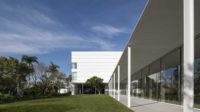Norton Art Museum Expansion by Foster + Partners
West Palm Beach, Florida

The museum's entrance canopy (shown) is carved out to accommodate a banyan tree, and it shelters the Typewriter Eraser sculpture.
Photo © Nigel Young

The museum's entrance canopy is carved out to accommodate a banyan tree, and it shelters the Typewriter Eraser sculpture (shown).
Photo © Nigel Young

Foster + Partners designed a new garden.
Photo © Nigel Young

The Great Hall features Eikón, a tapestry by Los Angeles–based artist Pae White.
Photo © Nigel Young

One current exhibition is Going Public: Florida Collectors Celebrate the Norton, which consists of nearly 50 works from private South Florida collections.
Photo © Nigel Young

Image courtesy Foster + Partners

Image courtesy Foster + Partners







Architects & Firms
When Floridians first heard that Norman Foster had agreed to take on the expansion of the Norton Museum of Art in West Palm Beach, they were impressed. It seemed surprising that the Pritzker Prize–winning architect, renowned for the Apple headquarters in California, the Gherkin in London, and the airport in Beijing, would accept a commission from a small museum specializing in American and European painting and Chinese works of art.
But the pairing was kismet. In 2010, Norton director Hope Alswang was in New York discussing a possible addition with museum trustee Gil Mauer, COO of the Hearst Corporation. Mauer asked which architect would top her wish list. Feeling cocky, she answered: “Norman Foster.” To which he replied, to her utter surprise, “I’ll call him right now.” Alswang didn’t realize that Mauer was the executive instrumental in bringing in Foster to design the new Hearst headquarters (2006) in which they were sitting.
Now, more than eight years later—“warp speed in museum time,” says Alswang—the Norton has been transformed. Not only does the museum have 35 percent more gallery space, but it has a new address, fronting South Dixie Highway. Foster explained why he made the change at a preview before the reopening last month.
While visiting the old museum in 2013, he approached what should have been the front door, facing the main road, and saw a sign that read, “Oops! This is not an entrance. Please follow the sidewalk to the south-facing entrance.” This made no sense to him, as the plan of the original Marion Sims Wyeth Art Deco building, completed in 1941, was organized on an east–west axis.
So Foster reestablished the original axis by building a wing along the west, with the new entrance on the highway (though in fact the museum’s first entrance had been on the east facade, facing a garden and the Intracoastal Waterway). The West Wing is topped by huge metal letters on the roof that announce the museum’s name to anyone driving down South Dixie. “It redefines the museum’s relationship with the city,” Foster said. But the defining feature of the new street frontage is a 43-foot-high cantilevered canopy of polished aluminum, cut in a razor-sharp curve to accommodate an 80-year-old banyan tree that Foster described as “the protagonist” of the project.
To reach the new entrance under the canopy, you cross a generous paved courtyard with a signature sculpture set in a shallow reflecting pool: the 19-foot-tall Typewriter Eraser, Scale X (1999), by Claes Oldenburg and Coosje Van Bruggen—an artwork the computer generation may well find puzzling.
The 59,000 square feet of the white stucco West Wing is comprised of four double-height volumes. A soaring lobby leads to the new spaces, including a dramatic 3,600-square-foot “Great Hall.” This public area, accessible without buying an entry ticket, is furnished with Eames/Saarinen lounge chairs, a coffee bar, book carts, and a grand piano. It features a spectacular oculus tucked into its 43-foot-high coved ceiling. In addition, Foster + Partners added an indoor/outdoor restaurant, a room for special events, a 210-seat state-of-the-art auditorium, and two classrooms. In collaboration with CBT Architects, Foster’s team also completely renovated the old galleries beyond the lobby and clarified the circulation throughout.
A separate new extension wraps around the south side of the 1941 building, with glass walls and a covered walkway, geared to protect art in the sunny climate. That leg of the addition looks out onto a 37,200-square-foot sculpture garden, the first landscape Foster + Partners has designed for an institution.
The Norton expansion is just the first phase of a Foster + Partners master plan that will ultimately transform the museum’s entire 6.3-acre campus. “As an architect, it’s fantastic when you get a green site,” said Foster, who was deeply involved in this project, “but it’s equally interesting and perhaps more challenging to take old buildings and bring a sense of cohesion, order, and clarity to them.”












